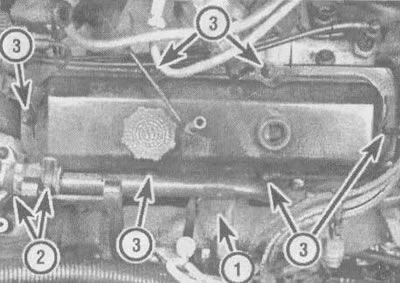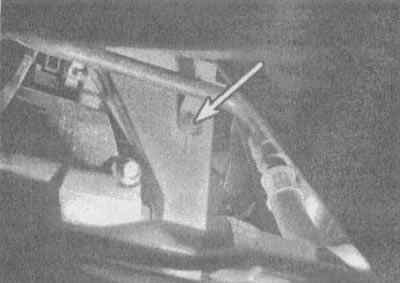Withdrawal
1. Disconnect the wire from the negative battery terminal.
2. Remove the air filter (see chapter 4, section 8).
Front valve cover
3. Disconnect the electrical connector of the idle air control motor (IAC) (see chapter 4, section 12).
4. Remove the engine mount damper (see illustration).

4.4. To access the valve cover, remove and disconnect the following components:
1 - Loosen the shock absorber nuts
2 - Having unscrewed the bolts, remove the shock absorbers
3 - Release the wiring harness from the clamp
4 - Disconnect the crankcase ventilation tube from the valve cover
5 - Disconnect the IAC valve electrical connector (in the photo it is already disconnected)
5. Release the wiring harness from the clip located on the valve cover on the side of the timing cover.
6. Disconnect wires from spark plugs (see chapter 1, section 33). In order not to make mistakes when assembling, mark each of them.
7. Remove the crankcase ventilation tube from the valve cover (see chapter 1, section 30).
8. Drain coolant (see chapter 1, section 29).
9. Having unscrewed the bolts, remove the cooling system pipe and thermostat housing from the cylinder head, disconnect the cooling system hose from the coolant pump and remove the pipe (see illustrations).

4.9a. To remove the front cover of the valve mechanism, unscrew this bolt from the thermostat housing (shown by arrow), which fastens the pipe of the cooling system,... | 
4.9b.... unscrew the bolt securing the cooling pipe bracket (1), compress the clamps (clamps) (2) coolant hose, disconnect the hose from the coolant pump, disconnect the cooling pipe from the thermostat housing and unscrew the nuts or bolts (3) valve cover fasteners (on some car models you may need a torx socket for this) |
10. Turn away bolts and nuts of a cover of the valve mechanism.
Note. On some car models, special bolts are installed. Unscrew them using the Togh T-30 head.
11. Remove the valve cover.
Note. If the cover is stuck to the cylinder head, try to loosen it with a block of wood and a hammer. If the cover still does not come off, pry it off carefully with a suitable tool, being careful not to damage the sealing flange.
Valve cover back
12. Disconnect the coolant temperature sensor and oxygen sensor (see chapter 6, section 4).
13. Disconnect wires from spark plugs (see chapter 1, section 33). In order not to make mistakes when assembling, mark each of them.
14. Remove the V-ribbed drive belt (see chapter 1, section 21).
15. Remove the generator (see chapter 5, section 13).
16. Disconnect the air conditioning tube bracket from the generator bracket (see illustration). Remove generator bracket (see illustration).

4.16a. Loosen this bolt (shown by arrow) and disconnect the air conditioning system line from the rear wall of the generator bracket | 
4.16b. To remove the alternator bracket from the engine, unscrew the bottom nut (shown by bottom arrow), disconnect the wire harness clamp and the power steering line clamp, then remove the nuts from all three studs |
17. Loosen the nuts (bolts) valve covers.
Note. Some car models are equipped with special bolts. Unscrew them with a Tox T-30 head.
18. Remove the valve cover.
Note. If the cover is stuck to the cylinder head, try to loosen it with a block of wood and a hammer. If the cover still does not come off, remove it by carefully prying with a suitable tool, being careful not to damage the flange.
Installation
19. Before installing the covers, the mating surfaces of each cylinder head and valve cover must be absolutely clean. Use a suitable scraper to remove any old seal or gasket material, then clean the mating surfaces with lacquer thinner or acetone (if sealing material or grease remains on the mating surfaces when the cover is installed, oil may leak through these places).
20. Replace the valve cover with a new gasket, then tighten the nuts or bolts. Tighten the bolts in several steps to the required torque specified in the specifications in this chapter.
21. Complete the installation in reverse order. After starting the engine, carefully check the valve cover-to-cylinder head connections for oil leaks.
